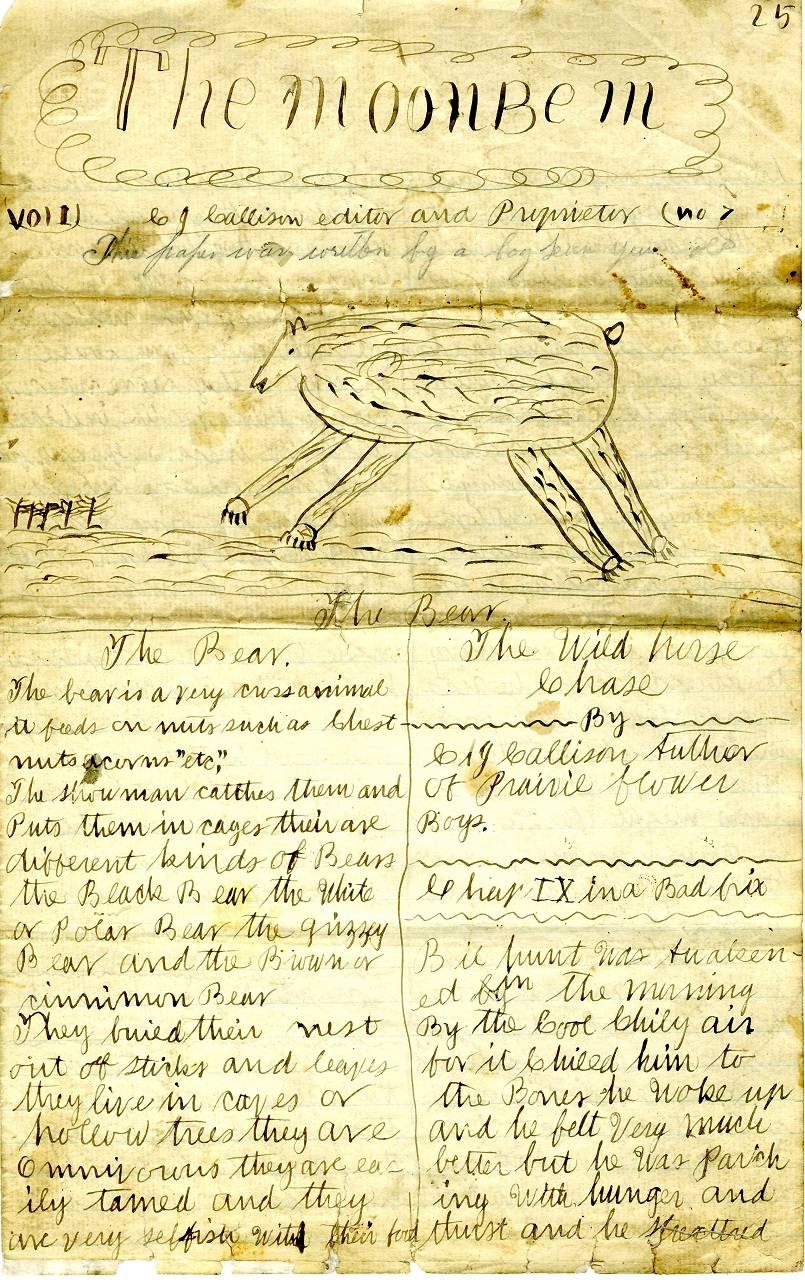In the courthouses of Virginia, one can often find records that are not and were never under the official purview of the clerks of the court. Newspapers, church minutes, private papers, and other records of these kinds turn up as the collections are searched by today’s researchers. The private papers of Charles J. Callison are an example of one such find in the Montgomery County Circuit Court records. Discovered in a file cabinet drawer of court judgments and estate bonds, the Callison papers consist of two issues of a handwritten newsletter titled “The Moonbeam,” two bound booklets, and a loose sheet of paper. Most of these seem to have been composed when Callison was a child or at least a young man. They concern his interests in hunting, nature, and wild adventure stories. There is no discernible reason why these papers should have found their way into the courthouse, but it is delightful to us that they did.
According to the 1880 federal census, Charles J. Callison was born in Virginia. Eighteen years of age at that time, he lived at home in Montgomery County with his parents and his five brothers and sisters. His father, Isaac, was a shoemaker according to the 1880 census and a farmer according to the 1900 census. Other information about Callison is thin on the ground. He served in the Spanish-American War in the 4th Virginia Infantry, Company G. Post-war he ended up on the west coast. The 1910 census finds him working as a coal miner in San Francisco. By 1920 he was in Washington state working as a laborer in a saw mill. According to the “Find A Grave” website, Callison committed suicide in 1927 at the age of 65 while a resident of the Washington Veterans Home in Port Orchard, Washington. He is buried in the Veterans Home Cemetery. He seems never to have married.
Written on both of “The Moonbeam” newsletters are notes to the effect that these were written and illustrated when the author was seven years old, making their composition date circa 1869.
The two newsletters, the loose paper, and the booklet titled “The Prairie Flower Boys” contain similar stories that may have been composed by Callison himself or copied from contemporary boys’ adventure magazines. They concern the friends William (or Bill) Crake, John Hardy, Jim Brick, Bill Hunt, and “your author” engaging in high adventures on the wild prairies of the Louisiana Purchase territory and are presented in serial form. The adventurers encounter bears and gaunt wolves, hunt deer, shoot prairie chickens, fight Indians, chop down trees to build a log cabin, and gather wild flowers. The style and subject matter is very much in keeping with the Victorian boys’ adventure magazines and books of the time.

Image of C. J. Callison's grave.
www.findagrave.com
The second bound booklet is titled “Score Book” and is a hunting journal covering the years 1876-1887. The first two pages are copies of parts of poems and songs celebrating the joys of the sport of hunting. The remainder of the journal is not strictly chronological although Callison documents his various hunting trips in the county over a period of years. He notes the weather, whose property he is hunting on, and the types and numbers of animals he shot including pheasants, partridges, rabbits, squirrels, and “bull bats” (the bird also known as the common nighthawk). Towards the end of the journal, Callison documents the tragic death of his hunting dog, Dash, in 1886.
The Callison private papers are part of the collection of the Montgomery County Circuit Court. To view these records, please request them at the desk in the Research Room of the Circuit Court at the Montgomery County courthouse in Christiansburg. These records are not available at the Library of Virginia.
The Moonbeam
The Prairie Flower Boys
Score Book
The historic court records inventory that uncovered the Callison papers and the processing and indexing of the Montgomery County chancery causes, 1777-1912, which is currently underway, have been funded in part by a two-year grant from the National Historical Publications and Records Commission (NHPRC). Additional information on this project can be found in an earlier blog post.
–Sarah Nerney, Senior Local Records Archivist





























Great find. Thank you for sharing.
This makes me happy … perhaps there are more records like this that would lead to a long lost ancestor.
Mary
Lutz, Fl